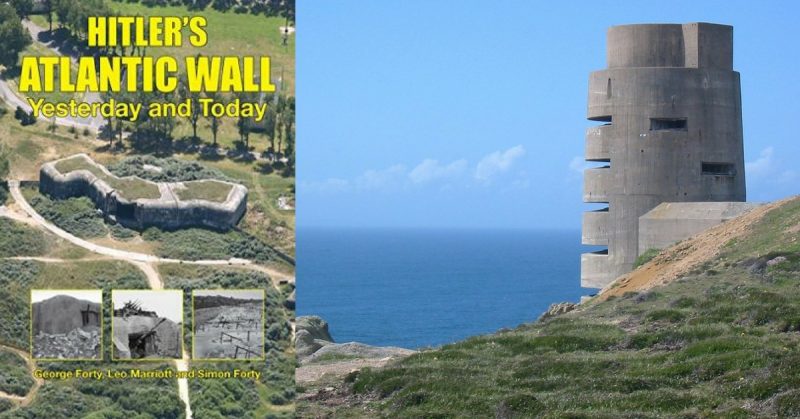The Forty-Marriott alliance has produced some interesting work in recent years as they sought different ways to produce what we might loosely term battlefield guides. It is a crowded market forever at war with the worldwide web and finding a device that adds a new dimension is definitely a good way to sell books. Ok, you might say; anyone can do a bit of aerial photography, but the style of these books is a real plus and the good work continues with this newest offering.
This time round the team turn their attention to the Atlantic Wall focusing on the construction, usage and remnants of the vast belt of concrete built by the Germans from France to Norway. I have to declare a serious interest here because my gang of mates have been exploring what for simplicity’s sake we will call bunkers for quite a few years. Battlefield touring has given us over a decade of adventures and while it started with the conventional circuit of memorials and museums from Normandy to Arnhem via the Somme and Flanders we were and are always seeking something more.
Mixing the two wars has been a delight and I recommend the flexible approach. I have done trips that concentrate on one conflict or single events, but the chance to mix it has seen my mob visiting Great War cemeteries and monuments on the same day as World War II shipwrecks and bunkers. It all works for me.
The thing about the Atlantic Wall is the scale and variety of bunkers, batteries, and emplacements built by a German occupier intent on keeping the Allies out or at the very least making them pay dearly for every yard of liberated soil. Some edifices are functional and compact while others are gargantuan. The variety is endless. The authors take us from southern France all the way to northern Norway offering a blend of history and technical information alongside an impressive array of images revealing what we can see today. I wish I had this book a decade ago.
Speaking from experience I must say that accessing some of these monsters is a matter of personal risk. I know of some flooded with dirty water hiding open hatches leading down to certain ruin. I’ve learned to wear a head torch and a hard hat isn’t a bad idea given the whacks my noggin has taken. I’m not so great with heights and ladders so leave the more adventurous stuff to my loony mates.
It’s a sad reflection of modern times that some of the bunkers around Calais have become home to migrants attempting to get into the UK and these places are not the casual adventure they once were. But there is so much to see and this book offers plenty of inspiration. I should stress that although I would use this book as a guide, it is primarily designed as a history and doesn’t encourage people being daft. That is entirely up to you!
The authors remind us that what seem like impregnable vestiges of the thousand-year Reich are actually far from it. Only recently a well-known harbor front site in Calais was torn down. Modern equipment makes these tasks so much easier. We can’t blame the locals for ridding themselves of reminders of a cruel occupation. France, in particular, is not a theme park. Some bunkers are just too unsafe as dunes and bases shift and the only option is to demolish them. While I think it is a shame, it is important to consider modern needs and health and safety laws.
My knowledge ends in Belgium. I haven’t explored the complexes built in the Netherlands, Denmark, and Norway. I hope to get to some one of these days. The Channel Islands are another blank. I remember exploring a few during my only visit to Jersey back in 1970. My family flew there from London Airport on a BEA Vickers Vanguard… showing your age Barnes!
This is a great book. It is fantastic to look at and the technical and historical info is all up to scratch. In a way it marks a point in time because I am sure some of the concrete monsters discussed are destined to be hammered to destruction in the near future. If I could recommend a site it would be the stunning Malo Terminus between Bray Dunes and Dunkirk. The huge Oldenburg bunker at Calais is a forbidding place. The vast array of Batterie Waldem is amazing, but try to remember your way back to your car and watch out for the hunters and their dogs. At all times you should remember the slave labourers who did the hard work as you marvel at the folly of the Nazis. None of these places are pretty. They are pure brutalism. But they are immensely important vestiges of modern European history and as such, we can only hope that some survive to remind us of what happened eighty years ago.
At all times you should remember the slave labourers who did the hard work as you marvel at the folly of the Nazis. None of these places are pretty. They are pure brutalism. But they are immensely important vestiges of modern European history and as such, we can only hope that some survive to remind us of what happened eighty years ago.
Reviewed by Mark Barnes for War History Online.

HITLER’S ATLANTIC WALL
From Southern France to Northern Norway, Yesterday and Today
By George Forty, Leo Marriott, and Simon Forty
Casemate Publishers
ISBN: 978 1 61200 375 7
